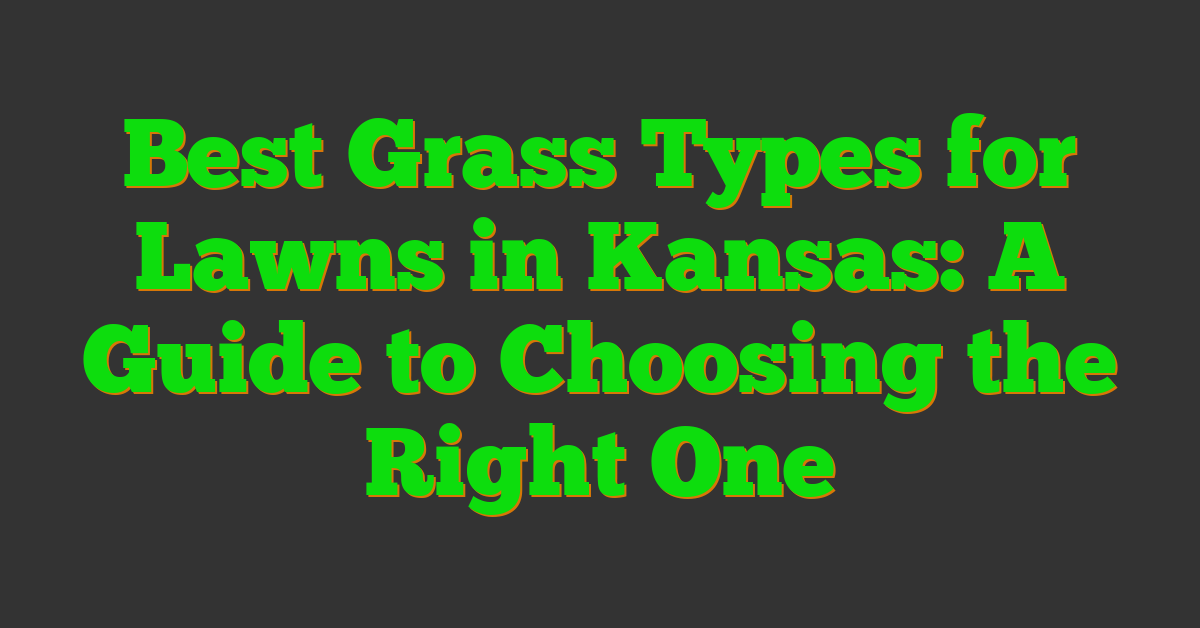If you’re a Kansas homeowner looking to cultivate a lush, healthy lawn, choosing the right type of grass is crucial. The climate and soil conditions in Kansas can be challenging for many types of grass, so it’s important to select a variety that can thrive in these conditions. In this article, we’ll explore the best types of grass for lawns in Kansas, including both cool-season and warm-season varieties.

Understanding Kansas’s climate and soil is key to selecting the best grass for your lawn. The state has a humid continental climate, with hot summers and cold winters. This means that grass varieties that can withstand both extreme heat and cold are necessary. Additionally, Kansas’s soil is typically alkaline and has a high clay content, which can make it difficult for some types of grass to thrive. By choosing a grass that is well-suited to these conditions, you can ensure that your lawn stays healthy and green throughout the year.
Why grass type matters cannot be overstated. Different types of grass have different growth habits, textures, and colors, and some are better suited to specific uses than others. For example, some grasses are better suited to high-traffic areas, while others are more shade-tolerant. By selecting the right type of grass for your lawn, you can ensure that it looks and performs its best.
Key Takeaways
- Understanding the climate and soil conditions in Kansas is crucial to selecting the best grass for your lawn.
- Different types of grass have different growth habits, textures, and colors, and some are better suited to specific uses than others.
- By selecting the right type of grass for your lawn, you can ensure that it looks and performs its best.
Understanding Kansas’s Climate and Soil

https://www.youtube.com/watch?v=mchHfHD7dOE&embed=true
When it comes to selecting the best grass types for your lawn in Kansas, it’s essential to understand the state’s climate and soil. Kansas has a continental climate, which means hot summers and cold winters. The state experiences an average of 50 inches of rainfall annually, with most of it occurring in the spring and summer months.
The soil type in Kansas varies, but most of the state’s soils are clay-based, which can make it difficult for water to penetrate and for grass roots to grow deep. It’s important to select grass types that are well-suited to the soil type in your area to ensure optimal growth and health.
Some of the best grass types for Kansas lawns include:
- Tall Fescue: Tall Fescue is well-suited for the transition zones in the southern parts of the state and could be considered the best grass for cities like Wichita, Kansas. It starts best by seeding.
- Zoysiagrass: Zoysiagrass is another great option for Kansas lawns. It’s heat and drought-resistant, making it ideal for the state’s hot summers. Zoysiagrass is also winter hardy, but it greens up later in the spring than bluegrass and tall fescue and turns brown in the fall after a hard frost.
- Bluegrass: Bluegrass is best adapted to northeast Kansas but grows statewide in well-drained loam soils. It is susceptible to a number of diseases and tends to form thatch. Bluegrass works well as long as the area has good soil.
- Buffalograss: Buffalograss is a warm-season grass that is native to the Great Plains region, including Kansas. It’s drought-tolerant and requires less maintenance than other grass types, making it an excellent choice for low-maintenance lawns.
When selecting a grass type for your Kansas lawn, consider the amount of sunlight your lawn receives, the soil type, and your lawn’s maintenance needs. By selecting the right grass type for your lawn, you can ensure a healthy and beautiful lawn all year round.
Why Grass Type Matters
https://www.youtube.com/watch?v=zfiTd1l4noA&embed=true
Choosing the right grass type for your lawn is crucial for its overall health and appearance. Different grass types have different characteristics that affect how well they grow, how much maintenance they require, and how they look. Here are some reasons why grass type matters when it comes to your lawn:
Appearance
The type of grass you choose can greatly affect the appearance of your lawn. Some grass types have a finer texture, while others are more coarse. Some are darker green, while others are lighter. Some grass types grow taller, while others stay shorter. All of these factors can affect the overall appearance of your lawn, and it’s important to choose a grass type that will give you the look you want.
Climate
Kansas has a continental climate with hot summers and cold winters. This means that the grass types that grow well in Kansas need to be able to handle both extremes. Cool-season grasses, such as Kentucky bluegrass and tall fescue, are generally the best choices for Kansas lawns because they can tolerate the cold winters and hot summers.
Maintenance
Different grass types require different levels of maintenance. Some grass types need to be mowed more frequently than others, while some require more water or fertilizer. It’s important to choose a grass type that fits your lifestyle and maintenance preferences. For example, if you don’t want to spend a lot of time mowing your lawn, you may want to choose a grass type that doesn’t grow as quickly.
Homeowners
Ultimately, the type of grass you choose for your lawn will depend on your personal preferences and needs as a homeowner. Some homeowners may prioritize appearance over maintenance, while others may prioritize low maintenance over appearance. It’s important to choose a grass type that fits your lifestyle and meets your needs.
Cool-Season Grasses for Kansas
https://www.youtube.com/watch?v=AS5P4KcgSTg&embed=true
If you’re looking for a lush, green lawn in Kansas, you’ll want to choose a cool-season grass. These grasses grow best in the cooler temperatures of spring and fall, making them ideal for the Kansas climate. Here are some of the best cool-season grasses for lawns in Kansas:
Kentucky Bluegrass
Kentucky bluegrass is a popular choice for lawns in Kansas. It’s a cold-tolerant grass that grows best in full sun, but can tolerate some shade. Kentucky bluegrass has a fine texture and a deep green color, making it a great choice for a beautiful, high-quality lawn. It’s also a durable grass that can withstand heavy foot traffic.
Perennial Ryegrass
Perennial ryegrass is another cool-season grass that’s well-suited for Kansas lawns. It has a fine texture and a bright green color, making it a great choice for a lush, attractive lawn. Perennial ryegrass also germinates quickly, so you’ll see results in a short amount of time. However, it’s not as durable as some other cool-season grasses, so it may not be the best choice for high-traffic areas.
Fine Fescues
Fine fescues are a group of cool-season grasses that includes creeping red fescue, chewings fescue, hard fescue, and sheep fescue. These grasses have a fine texture and a light green color, making them a good choice for a low-maintenance lawn. They’re also shade-tolerant, making them a good choice for lawns with trees or other obstacles that block the sun.
Other Cool-Season Grasses
In addition to Kentucky bluegrass, perennial ryegrass, and fine fescues, there are other cool-season grasses that can be used for lawns in Kansas. These include tall fescue, bentgrass, and colonial bentgrass. Each of these grasses has its own unique characteristics and growing requirements, so it’s important to choose the one that’s best suited for your lawn.
Overall, cool-season grasses are the best choice for lawns in Kansas. They’re able to withstand the extreme temperatures and weather conditions that are common in the state, and they’ll provide you with a beautiful, lush lawn that you can enjoy all year round.
Warm-Season Grasses for Kansas
https://www.youtube.com/watch?v=ltM9z5vsAHE&embed=true
If you live in Kansas and are looking for a grass that can handle the hot summers, you may want to consider warm-season grasses. These grasses are more tolerant of high temperatures and drought conditions, making them a great option for those living in the southern and western parts of the state.
« Best Grass Types for Lawns in Iowa: A Comprehensive Guide Best Grass Types for Lawns in Kentucky: A Guide to Choosing the Right One »
Two popular warm-season grasses for Kansas are Bermuda grass and Zoysia grass. Bermuda grass is a fine-textured grass that can handle high traffic and recovers quickly from damage. It is also drought-tolerant and can grow in a wide range of soil types. Zoysia grass, on the other hand, is a dense, low-growing grass that is known for its ability to tolerate shade and drought. It also requires less mowing than other grasses.
If you’re looking for a grass that is native to Kansas, Buffalo grass is a great option. This warm-season grass is drought-tolerant and can handle extreme temperatures. It is also low-maintenance and requires less water and fertilizer than other grasses. However, it may not be the best option if you have pets or children who like to play on the lawn, as it can be easily damaged.
Overall, warm-season grasses are a great option for those living in Kansas who want a grass that can handle the hot summers. Bermuda grass, Zoysia grass, and Buffalo grass are all great options to consider. Just make sure to choose the grass that best fits your needs and the requirements of your particular situation.
The Importance of Sunlight and Shade
https://www.youtube.com/watch?v=ePXKsOt8AEY&embed=true
When it comes to growing grass in Kansas, one of the most important factors to consider is the amount of sunlight your lawn will receive. Different grass types have varying levels of tolerance to sunlight and shade, so it’s important to choose the right type of grass for your lawn’s specific conditions.
If your lawn receives full sun for most of the day, you’ll want to choose a grass type that is well-suited to these conditions. Kentucky bluegrass is a popular choice for full sun lawns in Kansas, as it is a cool-season grass that thrives in temperatures between 45°F and 85°F. Other grass types that do well in full sun include Bermuda grass and Zoysia grass.
On the other hand, if your lawn is shaded for much of the day, you’ll need to choose a grass type that is more shade tolerant. Some grass types, such as fescue, are better suited to shaded areas and can still thrive with less sunlight. However, it’s important to note that even shade-tolerant grass types still require some amount of sunlight to grow properly.
If you have a mix of sun and shade in your lawn, you may want to consider a grass type that is adaptable to both conditions. Tall fescue is a popular choice for lawns with varying amounts of sunlight, as it can tolerate both full sun and partial shade.
In summary, the amount of sunlight your lawn receives is a crucial factor in determining which grass type is best for your lawn. Be sure to choose a grass type that is well-suited to your lawn’s specific conditions, whether that means full sun, shade, or a combination of both.
Grass Maintenance in Kansas
https://www.youtube.com/watch?v=6PbGcD2R_FE&embed=true
Maintaining a healthy lawn in Kansas requires a bit of effort, but it is worth it to have a beautiful, lush yard. Here are some tips to help you maintain your grass in Kansas:
Mowing
Mowing your lawn is essential to keep it healthy. In Kansas, the ideal mowing height varies depending on the grass type. For example, Kentucky Bluegrass should be mowed at a height of 2.5 to 3 inches, while Tall Fescue should be mowed at a height of 3 to 4 inches. Make sure to mow your lawn regularly, but never remove more than one-third of the grass blade at once.
Fertilizer
Fertilizing your lawn is important to keep it healthy and green. In Kansas, the best time to fertilize your grass is in the fall. Use a fertilizer with a high nitrogen content to encourage growth. Apply fertilizer evenly and follow the manufacturer’s instructions carefully.
Watering
Watering your lawn is crucial, especially during the hot and dry Kansas summers. Water your lawn deeply and infrequently, rather than frequently and shallowly. This will encourage deep root growth and help your grass withstand drought conditions. Water your lawn early in the morning or late in the evening to reduce evaporation.
Overseed
Overseeding is the process of spreading grass seed over an existing lawn to fill in bare spots and improve the overall density of the grass. In Kansas, the best time to overseed is in the fall. Make sure to choose a grass seed that is appropriate for your lawn’s conditions.
Low-Maintenance Grasses
If you are looking for a low-maintenance lawn in Kansas, consider planting Buffalo Grass or Bermuda Grass. These grasses require less water and fertilizer than other types of grass and can withstand drought conditions. However, keep in mind that they may not be as visually appealing as other grass types.
By following these tips, you can maintain a healthy and beautiful lawn in Kansas. Remember to adjust your maintenance routine based on the specific needs of your grass type and local weather conditions.
Dealing with Pests and Diseases
https://www.youtube.com/watch?v=em5t8bScq9s&embed=true
Maintaining a healthy lawn requires more than just watering and mowing. As a Kansas homeowner, you must also be vigilant about pests and diseases that can damage your grass. Here are some tips on how to deal with these common issues:
Weeds
Weeds are unwanted plants that can invade your lawn and compete with your grass for nutrients and water. To prevent weeds from taking over your lawn, you should:
- Mow your lawn regularly to prevent weed seeds from germinating
- Use a pre-emergent herbicide in the spring to prevent weed seeds from sprouting
- Pull weeds by hand or use a post-emergent herbicide to kill them
Insects
Insects such as grubs, chinch bugs, and sod webworms can cause significant damage to your grass by feeding on the roots and leaves. To control insect infestations, you should:
- Identify the type of insect that is causing the damage
- Apply an insecticide that is specific to the type of insect
- Follow the instructions carefully to avoid harming beneficial insects and pollinators
Diseases
Fungal diseases such as brown patch, dollar spot, and rust can cause discoloration, thinning, and death of your grass. To prevent and control fungal diseases, you should:
- Avoid overwatering your lawn, as excessive moisture can promote fungal growth
- Improve air circulation by pruning trees and shrubs and removing thatch
- Apply a fungicide when necessary, following the instructions carefully
Control
Preventing pests and diseases is always preferable to treating them. Here are some steps you can take to maintain a healthy lawn:
- Choose the right type of grass for your soil and climate
- Fertilize your lawn regularly to promote healthy growth
- Water your lawn deeply and infrequently to encourage deep root growth
- Aerate your lawn periodically to improve soil drainage and reduce compaction
By following these tips, you can keep your Kansas lawn healthy and beautiful for years to come.
Drought and Heat Tolerance
https://www.youtube.com/watch?v=LUFXSyU2vyc&embed=true
Kansas is known for its hot and dry summers, which can be tough on lawns. When choosing a grass type for your lawn, it’s important to consider its drought and heat tolerance.
Tall Fescue is a popular grass type in Kansas due to its high drought tolerance. It can withstand long periods of drought conditions and still maintain its green color. Tall Fescue can also handle high temperatures and is resistant to heavy wear and tear. It’s a great choice for lawns that receive a lot of foot traffic or for areas that don’t receive regular watering.
Bermuda grass is another grass type that is highly drought tolerant and can handle high temperatures. It’s a warm-season grass that thrives in hot and dry conditions. Bermuda grass is known for its deep roots, which help it to absorb water and nutrients from deep within the soil. It’s a great choice for lawns that receive a lot of sun and don’t receive regular watering.
Zoysia grass is a heat-tolerant grass that can also handle drought conditions. It’s a warm-season grass that is known for its dense, lush growth and is resistant to pests and diseases. Zoysia grass can handle high temperatures and can withstand long periods of drought conditions. It’s a great choice for lawns that receive a lot of sun and don’t receive regular watering.
When choosing a grass type for your lawn, it’s important to consider its drought and heat tolerance. Choose a grass type that can handle the hot and dry summers in Kansas, and your lawn will thrive even in the toughest conditions.
Foot Traffic and Wear Tolerance
https://www.youtube.com/watch?v=FpUYAMqDw2Q&embed=true
When choosing a grass type for your lawn in Kansas, you need to consider the amount of foot traffic it will receive. If you have kids or pets who love to play outside, you need to choose a grass type that can withstand heavy foot traffic. Athletic fields also require grass types that can handle constant foot traffic.
Tall Fescue is a popular grass type in Kansas that has moderate traffic tolerance and can handle foot traffic quite well. It has a deep root system that helps it withstand wear and tear. Perennial Ryegrass, on the other hand, has good wear tolerance but is more susceptible to diseases and insects, so it requires regular inspection.
If you need a grass type that can handle heavy foot traffic, consider Zoysiagrass. It has high traffic and wear tolerance, making it a popular choice for athletic fields and home lawns with lots of activity. However, it grows slowly, so it may take longer to establish than other grass types.
When it comes to foot traffic tolerance, Buffalo grass is an excellent choice. It can handle moderate foot traffic and requires less water than other grass types. It is also drought-resistant, making it ideal for areas with low rainfall.
In summary, when choosing the best grass type for your lawn in Kansas, consider the amount of foot traffic it will receive. Tall Fescue, Perennial Ryegrass, Zoysiagrass, and Buffalo grass are all excellent choices that can handle different levels of foot traffic and wear tolerance.
Choosing the Best Grass for Your Lawn
https://www.youtube.com/watch?v=khcjQvABIPI&embed=true
When it comes to choosing the best grass for your lawn in Kansas, there are several factors to consider. First, you’ll want to think about the climate and soil conditions in your area. Kansas has a continental climate with hot summers and cold winters, so you’ll want to choose a grass type that can handle both extremes.
One popular grass type for Kansas lawns is tall fescue. This cool-season grass is known for its tolerance to both heat and cold, making it a great option for the Kansas climate. It also has a deep root system, which helps it retain moisture and withstand drought conditions.
Another option is zoysiagrass, a warm-season grass that is well-suited to the hot summers in Kansas. This grass type is known for its dense, lush growth and ability to tolerate heavy foot traffic. However, it can be slow to establish and may require more maintenance than other grass types.
Bermudagrass is another warm-season grass that can thrive in Kansas. It is known for its durability and ability to withstand heat and drought conditions. However, it may require more water and maintenance than other grass types.
When choosing a grass type, it’s also important to consider the amount of sunlight your lawn receives. If you have a heavily shaded lawn, you may want to consider a grass type that is more shade-tolerant, such as fine fescue or Kentucky bluegrass.
Finally, consider your options for grass seed. There are many different seed options available for each grass type, so be sure to choose a high-quality seed that is well-suited to your lawn’s specific needs.
Overall, choosing the best grass for your lawn in Kansas will depend on a variety of factors, including climate, soil conditions, sunlight, and maintenance requirements. With careful consideration and research, you can find the perfect grass type and seed option to create a lush, healthy lawn.
Conclusion
https://www.youtube.com/watch?v=12Gxam7vvuc&embed=true
In conclusion, choosing the best grass type for your lawn in Kansas depends on several factors, including the amount of sunlight, soil type, and water availability. Kentucky bluegrass is a popular choice for its beautiful appearance and tolerance to cold temperatures. However, it requires regular watering and maintenance.
If you want a low-maintenance lawn, buffalo grass is a great option as it is drought-tolerant and requires less watering and mowing. Zoysiagrass is another low-maintenance grass that can withstand heat and drought. It grows slowly, which means less mowing, but it takes longer to establish.
Tall fescue is a versatile grass that can tolerate a variety of conditions, including shade and drought. It is also resistant to disease and pests. Bermuda grass is another option that can withstand heat and drought, but it requires regular watering and maintenance.
Ultimately, the best grass type for your lawn in Kansas depends on your specific needs and preferences. Consider factors such as maintenance, appearance, and environmental conditions when making your decision. With the right grass type and proper care, you can enjoy a beautiful and healthy lawn in Kansas.
Frequently Asked Questions
What type of grass grows best in Kansas?
Being located in the Midwest, Kansas is ideal for cool-season grasses. Kentucky Bluegrass, Perennial Ryegrass, and Fine Fescue are among the most popular grasses in Kansas.
What is the best quality lawn grass?
Kentucky Bluegrass is considered the best quality lawn grass for its fine texture, dark green color, and ability to self-repair.
What grasses are drought resistant in Kansas?
Buffalo Grass is a drought-resistant grass that is native to the Great Plains region, making it an excellent choice for Kansas lawns. Bermuda Grass and Zoysia Grass are also drought-resistant grasses that can thrive in Kansas.
Is ryegrass good in Kansas?
Perennial Ryegrass is a cool-season grass that is best suited for overseeding warm-season grasses in the fall. It has a fine texture and is quick to germinate, making it a popular choice for temporary lawns.
What are the benefits of Southern Fescue grass?
Southern Fescue grass is a cool-season grass that is known for its ability to tolerate heat and humidity. It has a deep root system that allows it to withstand drought conditions. It also has a fine texture and is disease-resistant, making it an excellent choice for lawns in Kansas.
What are the advantages of using Buffalo grass in Kansas?
Buffalo grass is a low-maintenance grass that is drought-resistant, making it an excellent choice for Kansas lawns. It has a deep root system that allows it to tolerate drought conditions, and it requires less water and fertilizer than other grasses. It also has a soft texture and a beautiful blue-green color that adds to its appeal.











